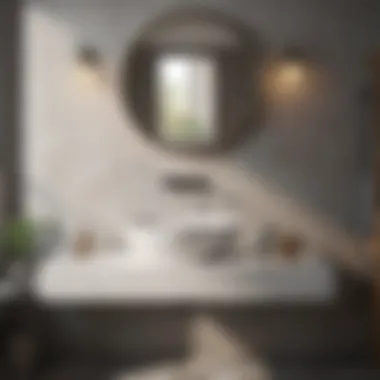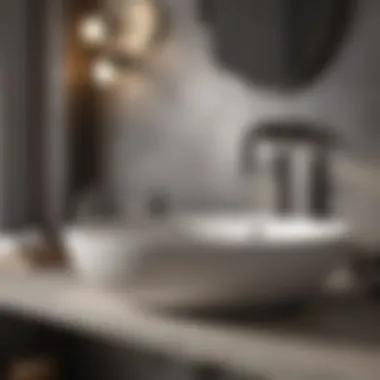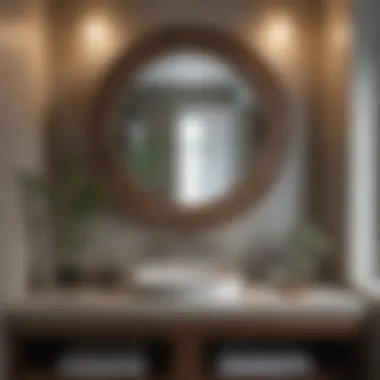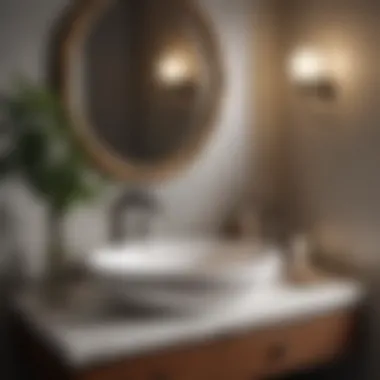Transform Your Bathroom with a Sink Remodel Guide


Intro
Remodeling a bathroom sink can be more than just a task on your to-do list; it’s an opportunity to elevate the entire bathroom experience. It often goes overlooked, yet the sink is frequently the centerpiece of any bathroom. Whether you're needing to upgrade an outdated sink or just looking to infuse new life into your space, proper planning is essential.
Staying current with trends, understanding material choices, and incorporating functional elements can transform a dull sink into a striking aspect of the room. This guide aims to walk you through a comprehensive viewpoint of what it takes to effectively remodel a bathroom sink. We’ll explore design inspirations, practical functionalities, and give you tips that will not only make the remodeling process smoother but also ensure that the final result is both elegant and practical.
As you embark on this remodel journey, let us delve into design inspirations to get your creative juices flowing.
Understanding the Bathroom Sink
The bathroom sink stands as more than just a functional fixture; it's a vital element that influences both the aesthetic and practical dimensions of your bathroom. Understanding the bathroom sink is about grasping what it embodies in your space—its role in daily routines, its contribution to overall bathroom design, and the variety of styles and materials permissible in creation. A sink remodel offers the chance to elevate a mundane space into a personal sanctuary while also adding value to your home.
Historical Context
The evolution of bathroom sinks closely mirrors changes in society's relationship with cleanliness and personal grooming. Historically, sinks were often merely practical, crafted from simple materials and featuring utilitarian designs. In ancient Rome, for instance, communal bathhouses boasted stone basins for washing, reflecting the empire's emphasis on hygiene and public health. As we leapt through time, the 19th century heralded a revolution in personal spaces. Technologies developed, and the ceramic sink became a standard in homes. They became symbols of modernity, representing the shift towards private bathing spaces.
Today, the sink can tell a story of its own, often carrying designs that nod to the past while marrying them with modern technology and functionality.
Importance in Bathroom Design
When one sets out to remodel their bathroom, an often-overlooked masterpiece is the sink. A well-chosen sink not only fulfills practical needs but also harmonizes with other design elements in the bathroom. Here are several points that underline its importance:
- Focal Point: A striking sink can serve as the centerpiece of a bathroom. Beyond functionality, it has the potential to catch the eye and create a stunning visual impression.
- Functionality: It’s not just about looks—the sink needs to effectively meet daily usage demands. The size, depth, and drainage capabilities often dictate how smoothly daily routines unfold.
- Integration: The sink can complement other fixtures and furnishings in the space. A sleek vessel sink may contrast beautifully with rustic cabinetry, highlighting a blend of styles.
- Expressive Design: From minimalist to ornate, the sink provides an avenue for personal expression in the bathroom—a way to infuse character, whether embracing trends or veering into unique territory.
The bathroom sink is not merely a fixture; it is an opportunity to blend durability with artistry, shaping the essence of your daily interactions with the space.
Understanding these facets showcases why the bathroom sink can be a game-changer in a remodel. Curious homeowners can creatively explore designs that serve both aesthetic and functional needs, leading to a transformative experience in their personal oasis.
Types of Bathroom Sinks
Understanding the various types of bathroom sinks is crucial for anyone looking to elevate their bathroom space. Each sink type carries unique characteristics, benefits, and aesthetic qualities that can drastically impact your overall design. Whether you're going for a classic look or aiming to capture a modern vibe, the sink plays a pivotal role not only in functionality but also in style. Exploring the different categories will empower homeowners to make an informed choice, ensuring that the aesthetic and practical needs of their space are met.
Pedestal Sinks
Pedestal sinks are often associated with traditional and timeless design. They consist of a basin mounted on a pedestal, creating a clean and elegant appearance. One of the key benefits of pedestal sinks is the space-saving feature they offer, making them an excellent choice for smaller bathrooms where every inch counts. With no visible plumbing, these sinks enhance the sense of openness and can make a compact space feel more airy.
However, it’s important to note that while they may look sleek, they generally offer less counter space for personal items. Homes with a classic design will appreciate the graceful lines and welcoming presence of pedestal sinks.
Wall-Mounted Sinks
Wall-mounted sinks bring a modern touch that elevates any bathroom. Fixed directly to the wall, these sinks leave the floor space open and provide an option for great accessibility, especially for those with mobility issues. They’re sleek and contemporary, giving the bathroom an uncluttered look that can be both chic and functional.
On the downside, careful plumbing considerations are necessary to ensure everything is properly secured, and you might find yourself sacrificing storage that would typically come with a traditional vanity. For the design-forward homeowner, wall-mounted sinks can truly transform the appearance of the bathroom.
Vessel Sinks
Vessel sinks have gained immense popularity due to their bold design and versatility. Simply put, these sinks sit atop a counter rather than being recessed. They can be round, square, or even uniquely shaped, which opens a world of possibilities for customization. This type comes in a myriad of materials, including glass, stone, and ceramic, allowing homeowners to express their style in ways that suit the overall interior theme.
However, vessel sinks do require additional consideration when it comes to the faucet height and spout design. It’s vital to ensure that water flows neatly into the sink to avoid splashes. While they can be a showstopper in any bathroom setting, remember that there's a practical element to factor in as well.
Basin Sinks
Basin sinks, also recognized as undermount sinks, are installed beneath the countertop. This integration creates a seamless look that many homeowners adore. The smooth lines between the counter and sink make cleaning a breeze, as there are no raised edges where dirt might collect.
Basin sinks offer a classic elegance that can complement both traditional and modern designs alike. Yet, the installation process is more intricate and typically requires a professional installer to ensure that everything is fitted correctly. This can impact the choice, especially for DIY enthusiasts or those on a tight budget.
In summary, choosing the right type of bathroom sink involves balancing aesthetic preferences against practical needs. Taking time to evaluate how each type fits into your overall design vision as well as functionality will ultimately lead you to the perfect sink for your space.
Choosing the Right Material
When diving into the world of bathroom sink remodeling, the material of your sink plays a crucial role. It's not just about aesthetics; the material you choose impacts functionality, durability, and ease of maintenance. By selecting the right material, you ensure that your sink not only complements your bathroom style but also withstands the test of time and daily use. Let's now take a closer look at some of the popular sink materials available to guide you through this pivotal decision.
Ceramic vs. Porcelain
Ceramic and porcelain are often seen as top contenders for bathroom sinks, but they aren’t identical twins. Ceramic refers to a broader category that includes glazed clay products, which can be less expensive and somewhat susceptible to scratching. Porcelain, on the other hand, is a type of ceramic that’s fired at higher temperatures, making it denser and more durable.
Having mentioned that, several benefits come with using either of these materials. Both offer a sleek, high-gloss finish that’s easy to clean, providing a chic look that fits well in various styles. However, porcelain's resilience against chips and stains can be perceived as a significant advantage.
"Choosing tougher material can save headaches down the road. Make it a priority!"
In addition, color variety is another topic worth pondering. While ceramic is often available in several colors, porcelain tends to shine when it comes to maintaining its color over time. The painted finish of ceramic sinks can fade or discolor with improper care, while porcelain remains steadfast, ensuring your sink stays vibrant.
Glass Sinks
If you’re considering a modern flair, glass sinks might catch your eye. These striking sinks add an element that’s hard to match. They come in a plethora of colors and styles, from transparent to etched designs. While they undeniably serve as stunning centerpieces, there are practical elements to consider.
Glass is non-porous, making it quite resistant to stains and easy to clean, yet it requires some caution. Regular cleaning with non-abrasive materials is essential to maintain that crystal-clear finish. One downside? Glass sinks can be fragile. A heavy impact could cause them to crack or shatter. Therefore, if you have young children or a high-impact environment, you might want to rethink that choice.
Stainless Steel Options
Stainless steel sinks have become a staple in modern architecture and design. They’re durable, resistant to scratches, and can handle high temperatures much better than their ceramic or glass counterparts. With a sleek, industrial appearance, stainless steel sinks can blend seamlessly into contemporary and minimalist bathroom styles.
Not to forget, these sinks are often easy to install and budget-friendly. However, one must remember they can scratch and show water spots easily, requiring regular maintenance to keep them looking clean and shiny. A little elbow grease goes a long way here, so make sure to keep them buffed and polished to maintain that sleek look.


Solid Surface Materials
Solid surface sinks are crafted from a blend of acrylic and polyester, and known for their seamless look and versatility. They offer a wide range of colors and finishes, allowing homeowners to customize their sinks to match any décor. These sinks blend into the countertop, giving a modern and clean appearance.
In terms of benefits, solid surface materials are non-porous, making them resistant to stains and easy to clean. They are also relatively durable, but keep in mind that they can be susceptible to scratches. A minor scratch is not a disaster, as solid surfaces can often be sanded down or buffed to refresh their appearance. When considering a solid surface sink, think about how much wear and tear it will experience.
Style Trends in Bathroom Sinks
When it comes to remodeling a bathroom sink, style trends play a pivotal role in determining not only the aesthetic value but also the functionality of the space. Today’s designs take into account various elements, ultimately aiming to balance visual appeal with usability. Homeowners and design enthusiasts alike benefit from understanding these trends, as they can be instrumental in creating a cohesive bathroom design.
Trends in bathroom sinks reflect broader design philosophies and can significantly enhance the ambiance of the space. A well-chosen sink can serve as a striking centerpiece, making a bold statement without overwhelming the rest of the bathroom. Furthermore, aligning your sink style with current trends can increase the overall value and allure of your home.
Minimalist Designs
In recent years, minimalist aesthetics have surged in popularity. This style emphasizes simplicity and functionality. Think clean lines, neutral colors, and unembellished surfaces. Often, sinks in this category are constructed with materials like stainless steel or composite stone, showcasing a sleek, understated elegance.
The benefits of minimalist designs include:
- Easy Maintenance: Fewer embellishments mean less dust and grime to manage.
- Timeless Appeal: These designs don't easily go out of style.
- Flexible Integration: Minimalist sinks fit seamlessly into various bathroom decors.
Considering their practical application, minimalist sinks encourage a clutter-free environment, promoting tranquility. For house owners aiming for an open and airy feel in their bathrooms, this style presents an ideal solution.
Rustic and Vintage Inspirations
A growing number of homeowners are embracing rustic and vintage inspirations in their bathroom sink designs. These styles offer a warmth and charm that evokes a sense of nostalgia. Whether it’s a weathered wood base or a deliberately aged faucet, these elements breathe life into the overall decor.
Rustic and vintage designs can often be defined by:
- Textured Finishes: Raw materials like stone or antique metals.
- Unique Shapes: Sinks with artisanal craftsmanship or custom designs.
- Color Variations: Earthy tones and soft pastels that evoke a relaxed atmosphere.
This approach is particularly appealing for those who want to create a cozy, inviting bathroom space. A vintage-inspired sink can act as the focal point, drawing attention and prompting conversations, thus enriching the home’s character.
Contemporary Aesthetics
Contemporary designs bring a fusion of innovation and practicality into the bathroom. Characterized by bold shapes, striking contrasts, and often experimental materials, these sinks attract lively attention. Many contemporary sinks focus on integrating technology, incorporating features such as touchless faucets or advanced drainage systems.
Key aspects of contemporary aesthetics include:
- Dramatic Silhouettes: From geometric shapes to organic forms.
- Innovative Materials: Use of resin, durable glass, or high-gloss finishes.
- Color Contrast: The pairing of dark and light tones adds depth and character.
For housewives looking to make a statement, a contemporary sink can elevate not just the room’s style but also its functionality. Its modern flair can be a showstopper, seamlessly fitting into both traditional and cutting-edge designs.
A well-thought-out sink design can transform an ordinary bathroom into a sanctuary of style and relaxation.
In summary, staying current with style trends in bathroom sinks can provide homeowners with numerous options that cater to various tastes and needs. Each of these styles carries its own unique benefits, adding to the overall character and functionality of the bathroom.
Functional Considerations
When it comes to a bathroom sink remodel, functional considerations should not be an afterthought. They play a pivotal role in ensuring that your space is as practical as it is appealing. Understanding the various factors that affect functionality can lead to a sink that not only looks great but also enhances your daily routines.
Size and Space
The size and space of your bathroom sink can drastically influence not just the aesthetics, but also the overall workflow in your bathroom.
Before diving into selections, measure the available area meticulously. A sink that’s too big can dominate a small bathroom, making it feel cluttered. Conversely, a sink that’s too small might not fulfill your needs. Consider how you use your sink daily – will there be multiple users? Do you need extra counter space?
For instance, if you're dealing with a compact area, a wall-mounted or a corner sink can be beneficial, making efficient use of the space without sacrificing style. On the flip side, if you have a spacious bathroom, a double-sink arrangement might be the ticket to harmony in a busy household, allowing ample room for two people to use the sink simultaneously without stepping on each other's toes.
"In designing a functional bathroom, it’s all about striking the right balance between size and utility."
Additionally, consider the height of the sink. A very low sink might be uncomfortable for taller individuals, while a very tall sink could be impractical for children or smaller adults. The right height contributes significantly to the comfort level during usage.
Drainage and Plumbing Needs
Nothing is worse than a beautifully remodeled bathroom that suffers from drainage problems or inadequate plumbing.
Before committing to a specific sink style or design, it's essential to evaluate existing plumbing requirements and your drainage system. Older homes may have pipes that don’t meet modern plumbing standards. If you’ve eyed an elegant vessel sink that sits atop the counter, be sure to check if your plumbing can accommodate the height and whether it allows for proper drainage.
Also, ensure that the water flow is steady and sufficient. Experts often recommend a faucet height that syncs well with the sink depth to avoid splash problems during use. While you might find a sleek design tempting, if it requires extensive reworking of the plumbing, that could result in a larger budget or more headaches down the line.
It's wise to decide if you will take on the plumbing work yourself or enlist the expertise of a professional. DIY might seem enticing, particularly with online tutorials, but any errors could lead to significant issues that go beyond aesthetic problems and upend your home routines.
DIY vs. Professional Installation
When it comes to remodeling your bathroom sink, you may find yourself at a crossroads: take on the task yourself or hire a professional to handle it. Both approaches have their merits, and the right choice often boils down to personal preferences, skill levels, and the complexity of the project at hand. Navigating this decision can significantly influence not just the outcome of your remodel, but also your overall satisfaction with the process.
Assessing Your Skill Level


Before you leap into the deep end of installation, a candid self-assessment is necessary. Consider the following:
- Experience with Handyman Tasks: Have you tackled home improvement projects before, or is this your first foray?
- Comfort with Tools: Are you familiar with basic plumbing and carpentry tools, or would navigating a wrench and tape measure be akin to learning a new language?
- Time Availability: Do you have ample time to dedicate to the project, or might your schedule inhibit your best efforts?
If DIYing seems like a stretch, remember: that’s perfectly okay! However, if you’ve got the confidence and time, rolling up your sleeves might just be the satisfying challenge you were hoping for.
Tools Required for Installation
Should you decide to tackle the job yourself, gathering the right tools is crucial. An incomplete toolbox can derail not just your workflow but lead to frustration. Essentials include:
- Pipe Wrench: Handy for loosening or tightening nuts and fittings.
- Plumber’s Tape: Helps create a watertight seal on threaded connections.
- Screwdriver Set: Both flathead and Phillips should be on hand.
- Caulking Gun: Useful for applying sealant for water protection.
- Level: Ensures the sink is perfectly aligned.
- Bucket: To catch any surprise water that might spill!
To make your life easier, familiarize yourself with how to use these tools properly, ensuring you’re not navigating blind into the realm of plumbing.
"The right tools in the hand of a capable owner can turn a daunting task into a manageable one."
In wrapping up this section, it’s essential to weigh the benefits and challenges of each side of the installation coin. Whether you choose to take on the project yourself or enlist the help of a pro, understanding your capabilities and preparing adequately can lead to a smoother remodeling experience.
Maintenance of Bathroom Sinks
Maintaining bathroom sinks is a key aspect of bathroom renovation that often doesn't get enough attention. Regular upkeep ensures that your sink not only looks good but also functions properly for years to come. An well-maintained sink can enhance your bathroom's aesthetic appeal while also providing essential functionality. It's all about creating a balance between beauty and practicality.
The benefits of maintaining your sink extend beyond the obvious. A clean, well-functioning sink minimizes the risk of clogs and leaks, saving you the headache—and expense—of plumbing repairs. Plus, proper care can prevent the growth of mold and mildew, a concern often overlooked but crucial in damp environments. In short, regular maintenance is not just about surface cleaning; it’s a cornerstone of long-term health and efficiency in your home.
Regular Cleaning Tips
To keep your bathroom sink in top shape, implement a few straightforward cleaning practices. Here are some effective steps to follow:
- Daily Wipe-Down: A simple rag or sponge can do wonders. Just give your sink a quick wipe every day to prevent soap scum and grime build-up.
- Use the Right Cleaners: Avoid harsh chemicals that can erode the finish of your sink. Instead, try natural solutions like a mix of vinegar and baking soda. It’s gentle but effective.
- Don’t Forget the Faucet: Often, faucets get neglected. Giving them a good scrub will prevent hard water stains. A soft toothbrush can reach those tricky spots.
- Monthly Deep Clean: Once a month, go for a more thorough cleaning. Empty the basin of any items, and clean every corner. A soft scrub brush works wonders here.
"A clean sink symbolizes a well-organized bathroom, making it feel more inviting and fresh."
Addressing Common Issues
Despite regular maintenance, some problems can still arise with bathroom sinks. Here are common issues and some tips on how to address them:
- Clogs: The bane of any homeowner's life. To tackle this, try a plunger first. If that doesn’t do the trick, you can try a mixture of baking soda followed by vinegar—which helps dissolve some blockages.
- Foul Odors: A smelly sink is usually a sign of trapped debris. Try running hot water down the drain and adding some dish soap to break up buildup.
- Corrosion and Scratches: For metal sinks, corrosion can be a sign of not using the right cleaner. Using a damp cloth with a sprinkle of baking soda can gently lift away scratches and tarnish.
- Rust: If you spot rust, it’s best to address it immediately to prevent spreading. A rust remover or simple vinegar soak can often do wonders.
Regular maintenance and knowing how to address potential issues will ensure your bathroom sink remains a centerpiece of elegance. Remember, by being proactive, you can keep costly repairs at bay.
Incorporating Accessories
When you think about remodeling a bathroom sink, the first images that come to mind might be of shiny new sinks and beautiful countertops. However, it’s often the accessories that turn a simple remodel into something extraordinary. Accessories not only enhance the utility of the sink area but also contribute significantly to the overall aesthetic. From practicality to style, focusing on the right accessories can change the whole vibe of your bathroom.
Accessories allow homeowners to express their personality while also considering functionality. By carefully incorporating elements such as faucets and basin add-ons, you transform your space without needing to undergo a massive overhaul. Here’s where the real fun begins.
"The right accessories can elevate even the simplest of designs to bring harmony and interest to the room."
Faucet Options
Faucets are often the centerpiece of any bathroom sink. They can be the difference between a modern minimalist look or something rustic and vintage. When you're on the hunt for a faucet, you want to consider factors like style, function, and finish—not to mention water efficiency.
Here’s a list of popular options:
- Single-handle faucets: Simple and easy to use. Just one lever controls both temperature and flow, making them a great choice for busy households.
- Dual-handle faucets: These models allow for more precise temperature adjustment and might appeal to those who prefer a more traditional style.
- Pull-down sprayer faucets: Ideal for those who need that extra flexibility for rinsing and cleaning. They bring a modern touch while being super practical.
- Touchless faucets: With touchless technology gaining ground, these faucets offer convenience and hygiene. They are perfect for family households or anyone who cooks a lot.
Ultimately, selecting a faucet should align with the overall theme of your bathroom while satisfying your daily needs. The finish (chrome, brushed nickel, or oil-rubbed bronze) plays a pivotal role in durability and style, ensuring it meshes well with other elements in your space.
Basin Accessories
When it comes to basin accessories, the options are vast and can dramatically improve the functionality and design of your sink. Consider these accessories that can seamlessly enhance your bathroom aesthetics:
- Sink mats: Protects the basin from scratches and adds comfort during use. Some mats come in various colors and designs, so you can easily match them to your décor.
- Drain strainers: A practical essential to prevent clogs while adding a touch of flair. Their designs vary, from simple mesh to ornate patterns.
- Soap dispensers and cups: Both soap dispensers and rinsing cups can be installed to harmonize with the faucet. Available in sleek or whimsical designs, they allow you to keep essentials organized without cluttering the counter space.
- Basin racks: These are a game-changer for anyone who wants to maximize drying space while maintaining a tidy sink area. Look for customizable options suited to your sink size.
Incorporating these accessories not only elevates the appearance of the sink but also allows for a more efficient use of space. The synergy between style and practicality makes every interaction with your bathroom sink more pleasurable.
Sustainable Practices
In recent years, as the world grapples with the implications of climate change and resource depletion, the importance of sustainable practices in home improvement projects, including bathroom remodels, cannot be overstated. A bathroom sink remodel is not merely about enhancing aesthetics; it also provides an opportunity to embrace eco-friendly options. By prioritizing sustainability, homeowners can positively impact the environment while simultaneously reaping long-term benefits, such as reduced resource consumption and lower utility bills.
Eco-Friendly Materials
When considering a bathroom sink remodel, the choice of materials is paramount. Opting for eco-friendly materials can play a significant role in reducing your carbon footprint. Here are some appealing options:
- Recycled Glass: Sinks made from recycled glass not only look striking but also divert waste from landfills. They come in various colors and styles, making them versatile for any design preference.
- Bamboo: Known for its rapid growth and renewability, bamboo can be used for sink cabinets or countertops. This natural material adds warmth and texture, creating an inviting space.
- Low-VOC Paints: If opting for a painted finish, choosing low-volatile organic compounds (VOCs) paints ensures the air inside your bathroom remains clean and healthy. Regular paints can emit harmful gases, particularly in enclosed spaces.
- Stone Materials: Natural stones like granite or marble, sourced responsibly, provide durability and timeless aesthetics. They can last for years, minimizing the need for replacements and the waste that comes with them.
By selecting such materials, you’re not just making responsible choices; you’re also investing in quality that stands the test of time. This reduces the frequency and waste associated with renovations.


Water-Saving Features
Water is one of Earth's most precious resources, and it's prudent for homeowners to factor in water-saving features during their bathroom sink remodel. Here are effective ways to implement these features:
- Low-Flow Faucets: Unlike traditional faucets, low-flow models limit the flow of water without sacrificing performance. This simple adjustment can lead to substantial water savings over time.
- Aerators: Installing aerators on faucets blends air with water, reducing the amount of water flowing out while maintaining pressure. This small addition is low-cost and highly effective.
- Smart Technology: Newer technologies, such as motion sensors or foot-pedal operated faucets, conserve water by ensuring that it’s only used when necessary. These smart solutions not only save water but can enhance the overall user experience.
- Efficient Drainage Systems: An efficient drainage setup can help with quick water release and minimize buildup, thus enhancing the sink's longevity.
By incorporating these water-saving features, homeowners can significantly reduce their water consumption. Not only does this result in lower utility bills, but it also contributes to broader conservation efforts.
In essence, embracing sustainable practices during a bathroom sink remodel reflects a commitment to improving not just your living space but also the world around you.
Budgeting for Your Remodel
When it comes to remodeling your bathroom sink, budgeting is a critical aspect that can’t be overlooked. Setting a realistic budget not only guides your decisions but also helps avoid the pitfalls of overspending or compromise on quality. Understanding what you can afford and what you wish to achieve is key in elevating your overall bathroom design.
A well-structured budget allows you to make informed choices. Whether you’re opting for a luxurious vessel sink or a sleek wall-mounted option, knowing how much you can allocate to each major element - the sink itself, fixtures, and installation - empowers your project. No one wants to get halfway into a remodel only to realize they are out of cash and left with an incomplete project.
Cost Breakdown of Sinks
The variety of sinks available today can vary wildly in price, depending on several factors such as materials, brand, and design style. Here's a breakdown:
- Ceramic Sinks: Generally among the most affordable, prices range from $100 to $300, depending on finish and style.
- Vessel Sinks: These stylish options typically range from $150 to $700, reflecting their design appeal and sometimes unique materials like glass or stone.
- Pedestal Sinks: Ranging from about $100 to $1,000, the price often hinges on the intricacies of design and brand reputation.
- Glass and Stainless Steel Sinks: These can start around $250 and can go upwards of $1,000, offering sleek, modern looks.
It's important to shop around and consider checking online marketplaces like Facebook or Reddit for second-hand options, which can sometimes yield great deals without sacrificing quality.
Estimating Installation Costs
When it comes to installation costs, the figures can fluctuate based on the complexity of the project and local labor rates. Here's a rough estimate:
- Professional Installation can range from $150 to $500, depending on your location and how challenging the install is.
- DIY Installation is much cheaper, requiring just your time and tools. However, make sure you're comfortable with plumbing tasks to avoid costly mistakes.
It's wise to consider additional factors like plumbing modifications, which may add anywhere from $200 to $800 to your budget if changes are required to accommodate your new sink.
"Planning your finances is like securing the ship before you sail into uncertain waters. You wouldn’t set out without a map!"
Overall, thorough budgeting for your bathroom sink remodel involves understanding both the visible costs of the sink itself and the often-overlooked expenses of installation and any necessary plumbing revisions. Balancing your aspirations with practical financial limits can be a game-changer for the success of your remodel.
Case Studies
When delving into the realm of remodeling bathroom sinks, case studies serve as a significant compass guiding the way. Through real-life examples, one can glean not just successful strategies but also the pitfalls to dodge. This section emphasizes the tangible results that have been achieved through thoughtful renovations. By diving into case studies, homeowners can understand trends and their implications for enhancing both aesthetics and functionality in bathroom spaces.
Successful Remodels
Residential Projects
Residential projects underscore the personal touches that can transform a common space into a unique sanctuary. These projects often capture the essence of individual style while addressing functional needs. A notable characteristic of residential remodels is the customization aspect. Homeowners often choose unique sinks and materials that reflect their personality, making each bathroom one-of-a-kind.
For instance, a family in the suburbs selected a reclaimed wood-beamed basin sink paired with artisanal bronze faucets. Not only did this choice elevate the aesthetic appeal, it utilized sustainable materials—an increasingly popular trend among homeowners keen on eco-friendly solutions.
The main advantage of such projects lies in their ability to combine luxury with personal preference. However, these choices sometimes come with disadvantages, particularly regarding upkeep and cost implications. When deciding on distinctive fixtures, one must also consider maintenance demands, as holistic design should account for future durability and practicality.
Commercial Spaces
On the flip side, commercial spaces offer a different take on bathroom remodels. Here, functionality is paramount due to high traffic and varied user needs. Commercial renovations often involve maximizing space and ensuring ease of use, catering to a broad audience rather than a specific personal taste.
A key characteristic of these remodels is the focus on materials that withstand wear and tear. For example, a busy restaurant might choose a commercial-grade stainless steel sink integrated with a modern faucet system. This kind of setup not only meets the aesthetic standards of the space but also complies with health regulations.
In short, the unique feature of commercial projects is their capacity to balance functionality with visual appeal. The advantages include easier maintenance and enhanced durability. However, the disadvantage sometimes lies in the lack of personalization; commercial sinks might not always align with a specific design vision that appeals to individual style.
Before and After Analysis
A look at before and after analyses provides further insight into how effective remodeling can reshape a bathroom sink’s role within a space. By studying these transitions, homeowners can recognize potential strategies to inspire their projects.
In summary, analyzing case studies equips readers with the knowledge to make informed decisions, enhancing their remodeling journey with wisdom gathered from others' experiences.
Culmination
In this fast-paced world, where we often neglect the small spaces in our homes, revamping your bathroom sink can be a vital step toward creating a serene and functional environment. The process of remodeling the sink area goes beyond basic aesthetics; it weaves together utility, comfort, and style.
In our exploration of bathroom sinks, we've emphasized the importance of aligning the right style and material with personal taste and practical needs. Choosing a sink is not simply a selection of a product from a store; it reflects on your lifestyle and can enhance or detract from your bathroom's overall atmosphere.
Moreover, the discussion of sustainable practices and budgeting for your remodel underscores the long-term benefits of careful planning and decision-making. With the increasing emphasis on eco-friendly solutions, consciously selecting materials and fixtures not only conserves resources but contributes to the aesthetic value of your space. This thoughtfulness capitalizes on both current trends and timeless elegance.
Ultimately, the functionality of your bathroom sink ties directly into your daily routine. From washing hands to preparing for the day, a well-chosen sink simplifies tasks and enhances productivity. Evaluating size, style, and accessibly not only contributes to the beauty of the bath but also supports household efficiency.
Summary of Key Points
- The right bathroom sink can significantly elevate the style and utility of your bathroom.
- Material selection plays a critical role in durability and maintenance.
- Sustainable choices impact not only aesthetics but also environmental concerns.
- A well-planned remodel maximizes both existing space and overall functionality.
Final Thoughts on Remodeling
Remodeling your bathroom sink isn't just about the sink – it's the cherry on top of a broader vision for a well-designed bath space. Think of it as your chance to make a distinct statement while enjoying practical benefits. By following the insights shared in this guide, you can achieve a transformation that reflects your personality and meets the demands of modern living.
Don't rush to make a decision; take time to explore various designs and materials. Seek inspiration from various sources or consult professionals who can lend expert advice. No detail is too small when it comes to creating a bathroom that feels like a sanctuary. A thoughtful approach ensures that, at the end of the day, your bathroom sink will not only look stunning but also serve you well for years to come.















